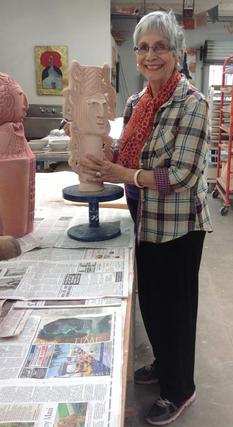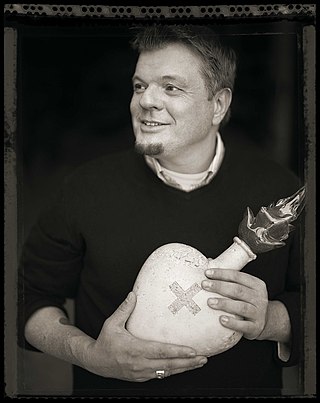
Rembrandt Peale was an American artist and museum keeper. A prolific portrait painter, he was especially acclaimed for his likenesses of presidents George Washington and Thomas Jefferson. Peale's style was influenced by French neoclassicism after a stay in Paris in his early thirties.

The National Museum of Women in the Arts (NMWA), located in Washington, D.C., is "the first museum in the world solely dedicated" to championing women through the arts. NMWA was incorporated in 1981 by Wallace and Wilhelmina Holladay. Since opening in 1987, the museum has acquired a collection of more than 6,000 works by more than 1,000 artists, ranging from the 16th century to today. The collection includes works by Mary Cassatt, Alma Woodsey Thomas, Élisabeth Louise Vigée-LeBrun, and Amy Sherald. NMWA also holds the only painting by Frida Kahlo in Washington, D.C., Self-Portrait Dedicated to Leon Trotsky.
Andrea Way is an American artist currently based in Washington, D.C.

The Cyrus and Myrtle Katzen Arts Center is home to all of the visual and performing arts programs at American University and the American University Museum It is located at Ward Circle, the intersection of Nebraska Avenue and Massachusetts Avenues in Washington, D.C. This 130,000-square-foot (12,000 m2) space, designed to foster interdisciplinary collaboration in the arts, provides instructional, exhibition, and performance space for all the arts disciplines. Its 30,000-square-foot (3,000 m2) art museum exhibits contemporary art from the nation's capital region and the world. The museum gallery is the Washington region's largest university facility for art exhibition.

The American University Museum is located within the Katzen Arts Center at the American University in Washington, DC.
Enrique Chagoya is a Mexican-born American painter, printmaker, and educator. The subject of his artwork is the changing nature of culture. He frequently uses shocking imagery, irony, and Mesoamerican icons to convey his point in his artwork. Chagoya teaches at Stanford University, in the department of Art and Art History. He lives in San Francisco.
Lila Katzen, born Lila Pell, was an American sculptor of fluid, large-scale metal abstractions.

Carol Brown Goldberg is an American artist working in a variety of media. While primarily a painter creating heavily detailed work as large as 10 feet by 10 feet, she is also known for sculpture, film, and drawing. Her work has ranged from narrative genre paintings to multi-layered abstractions to realistic portraits to intricate gardens and jungles.

Dora De Larios was an American ceramist and sculptor working in Los Angeles. She was known for her work's clean lines and distinctive glazes, as well as for her line of tableware created under her family-run company Irving Place Studio. Also a muralist working with tile, De Larios was noted for her style, which reflects mythological and pan-cultural themes.
Aram Han Sifuentes is a Korean American social practice fiber artist, writer, curator, and an adjunct professor at the School of the Art Institute of Chicago.
Val Edwin Lewton was a painter and museum exhibition designer. As an artist, he created Realist acrylic paintings and watercolors of urban and suburban scenes, predominantly in the Washington, D.C., area, where he lived and exhibited.

Harriet Christina Cany Peale was an American landscape, portrait, and genre painter of the mid-nineteenth century. Although sometimes described as a copyist, a greater share of her oeuvre has been made public in recent years, allowing Cany Peale to earn recognition for her genre and landscape paintings. She has been located in contemporary scholarship as an artist of the Hudson River School.

Tim Tate is an American artist and the co-founder of the Washington Glass School in the Greater Washington, DC capital area. The school was founded in 2001 and is now the second largest warm glass school in the United States. Tate was diagnosed as HIV positive in 1989 and was told that he had a year left to live. As a result, Tate decided to begin working with glass in order to leave a legacy behind. Over a decade ago, Tate began incorporating video and embedded electronics into his glass sculptures, thus becoming one of the first artists to migrate and integrate the relatively new form of video art into sculptural works. In 2019 he was selected to represent the United States at the sixth edition of the GLASSTRESS exhibition at the Venice Biennale.
Amber Robles-Gordon is an American mixed media visual artist. She resides in Washington, DC and predominantly works with found objects and textiles to create assemblages, large-scale sculptures, installations and public artwork.
Ric Garcia is an American fine arts painter, digital printmaker, and curator of Cuban ancestry currently working and residing in the Greater Washington, DC area.
Thomas Patrick Green, Jr., known more commonly as Tom Green, was an American painter and professor. He taught at Corcoran College of Art and Design, for many years. Green is associated with the Washington Color School art movement.
Kenneth Victor Young (1933–2017), was an American artist, educator, and designer. He is associated with the Washington Color School art movement. He worked at the Smithsonian Institution as an exhibit designer for 35 years.
The Looking Glass: Artist Immigrants of Washington was a curated invitational art exhibition held from June 18 through August 14, 2016 at The American University Museum at the Katzen Arts Center in Washington, DC.
Julia Kwon (1987–present) is a Korean-American artist best known for her bojagi-inspired artwork. Her work has been featured at the Smithsonian Institution's Cooper Hewitt Museum and Smithsonian American Art Museum.
Sharon Kerry-Harlan is an African-American artist active in Hollywood, Florida and Wauwatosa, Wisconsin who is known for her textile art. She was born in Miami, Florida in 1951. She graduated with a Bachelor of Arts degree from Marquette University and studied at the Milwaukee Institute of Art & Design. She went on to work at Marquette University as an Academic Coordinator and to teach textile courses at University of Wisconsin–Milwaukee as an adjunct professor. From July to August 2019, Kerry-Harlan had a solo exhibition at the James Watrous Gallery at the Overture Center for the Arts. Throughout August 2019, her work was on display in the AndStill We Rise: Race Culture and Visual Conversations exhibit at the Mariposa Museum & World Cultural Center in Oak Bluff, Massachusetts. In early 2021, Kerry-Harlan participated in the Textile Center and Women of Color Quilters Network’s juried exhibit Racism: In the Face of Hate We Resist. Later that year, Kerry-Harlan's work was displayed in the Museum of Wisconsin Art's Claiming Space Exhibition. In 2022, her work, Portrait of Resilience, from the Flag Series, was acquired by the Smithsonian American Art Museum as part of the Renwick Gallery's 50th Anniversary Campaign in 2022. That same year, Kerry-Harlan's work was displayed in the Madison Museum of Contemporary Art's exhibit Ain’t I A Woman? in celebration of the 2022 Wisconsin Triennial. She also had work displayed in the 2022 Uncovering Black History: Quilts from the Collection of Carolyn Mazloomi exhibition at the International Quilt Museum in Lincoln, Nebraska.








